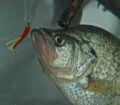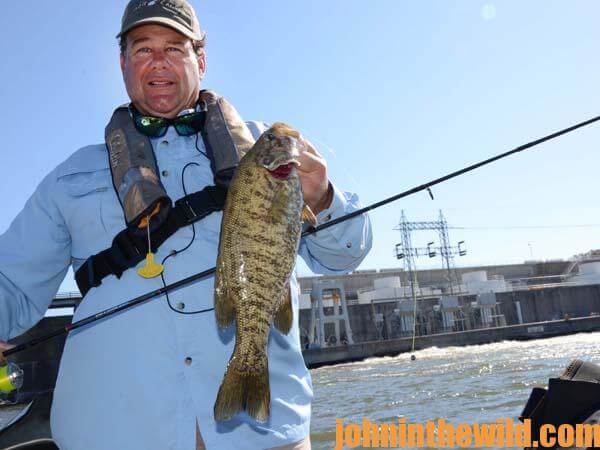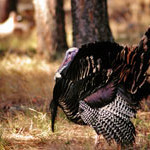John’s Note: You can catch truckloads of catfish during the fall and winter on the Tennessee River that runs through Tennessee, Alabama and Mississippi, if you know how to troll for catfish. In late October, I learned a technique that makes catfishing fun and productive all the way up until about Christmas. This week Brian Barton of Muscle Shoals, Alabama, a professional catfish and smallmouth guide, will teach us all how to catch fall and wintertime cats.
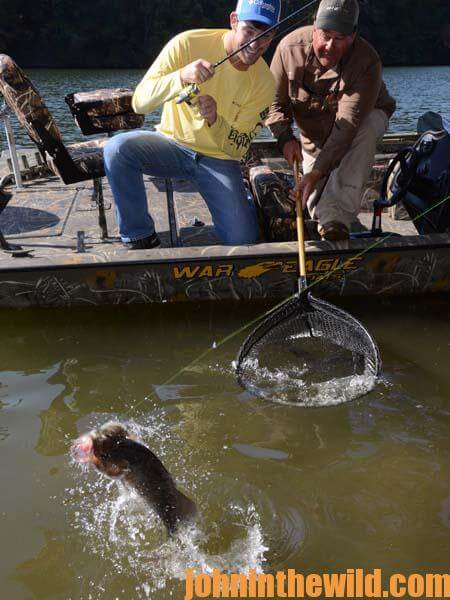 Besides guiding for catfish, I also guide for smallmouth bass. The Alabama state record for smallmouth bass is 10 pounds, 8 ounces, caught by Owen F. Smith of Fairfield, Ala. on October 8, 1950. On Wilson Lake during the spring and fall, we have a tremendous run of smallmouths in the tailrace of Wheeler Dam, the headwaters of Wilson Lake on the Tennessee River. Smallmouths are current feeders. They love the swift water, and they enjoy eating all the baitfish that come through the hydroelectric plant at the base of the dam.
Besides guiding for catfish, I also guide for smallmouth bass. The Alabama state record for smallmouth bass is 10 pounds, 8 ounces, caught by Owen F. Smith of Fairfield, Ala. on October 8, 1950. On Wilson Lake during the spring and fall, we have a tremendous run of smallmouths in the tailrace of Wheeler Dam, the headwaters of Wilson Lake on the Tennessee River. Smallmouths are current feeders. They love the swift water, and they enjoy eating all the baitfish that come through the hydroelectric plant at the base of the dam.
I don’t believe there is any better way to catch more or bigger smallmouths than fishing with live shad minnows. I catch my shad minnows in a cast net and keep them in a large round bait tank. Then they’ll stay alive and lively, until we’re ready to fish with them. I use 8-pound-test monofilament line on a spinning rod and a Daiichi hook (http://www.ttiblakemore.com). At the end of the line, I’ll put a shot lead about a foot up from the hook. The size of the shot lead is determined by how fast the current is coming out of the hydroelectric plant.
There are two or three main places to catch smallmouths at the base of Wheeler Dam. The most-consistent site is to go up to the face of the dam and get between two currents being discharged out of the turbines in the hydroelectric plant. Where these two currents collide is called the seam. When current comes out of one turbine and hits the current coming out of the turbine next to it, at the point where these two currents meet, the water is much more slack than it is anywhere else where the turbines are running. The baitfish, smallmouth and many other species of fish hold in the slack water. I’ll pull my boat up close to the face of the dam and let it drift, and my anglers cast out into the middle of the seam. The shot lead lets the bait get down close to the bottom where the smallmouths are feeding.
I’ll hook my live shad minnow through its bottom lip and bring the point of the hook out its nostril. Then, when the minnow hits the water, it can swim naturally down near the bottom. Once the smallmouth takes the bait, the line usually will be slack. You want to reel the slack out of your line and use a sweeping motion to set the hook. Remember, you’re only fishing with 8-pound-test line. If you try to set the hook really hard, there’s a good chance you’ll break your line. I like to fish with B‘n’M Float and Fly Rods (https://www.bnmpoles.com/c-12-float-fly-rods.aspx). These long limber rods help soften the strikes, yet keep tension on the line the entire time my angler is fighting the fish. Because these smallmouths spend a good portion of their time fighting against the current, they put on a really-hard fight and will go airborne. By using the B‘n’M Float and Fly Rods, my angler is keeping constant pressure on the smallmouth from the time the fish takes the bait until we land it.
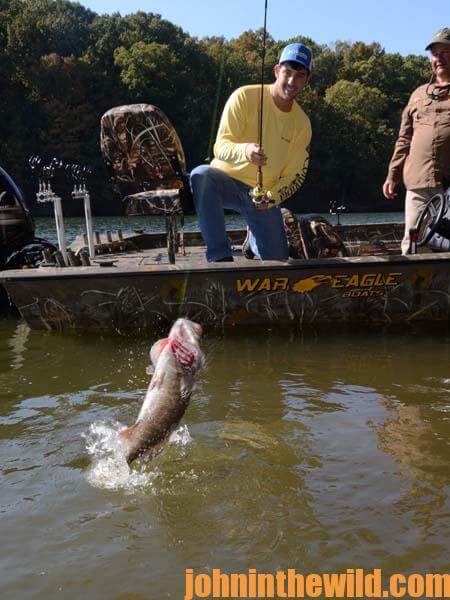 One of the thrills of fishing in that swift water and letting a shad minnow swim through the seams is that you never know what you may catch. Although we’re primarily fishing for smallmouths, we often catch largemouths, catfish, drum, saltwater stripers and hybrid striped bass. Almost any fish that swims in Wilson Lake will eat that live shad as it swims near the bottom of a seam.
One of the thrills of fishing in that swift water and letting a shad minnow swim through the seams is that you never know what you may catch. Although we’re primarily fishing for smallmouths, we often catch largemouths, catfish, drum, saltwater stripers and hybrid striped bass. Almost any fish that swims in Wilson Lake will eat that live shad as it swims near the bottom of a seam.
Another great region to catch smallmouths is just off the side of a running turbine. The seam that’s created here is where the eddy water coming off the side of the current is the calm water. Even though you’ll often catch the same types of fish you’ve caught when fishing two colliding currents, you’ll often catch largemouths that lay off the current but close enough to dart out from the calm water into the swift water to eat shad.
When we’re fishing in the tailrace, I ask my anglers to keep baits on their spinning rods, because often their leads will tag the bottom and get hung. Usually, by bouncing your rod tip and letting off a little line, you can free your hook and let the minnow continue to swim down the seam. If you decide to fish the tailrace of any of the dams on the Tennessee River during the spring, not only do the smallmouths migrate up the river and congregate in the tailraces, so do the catfish. Anglers may catch from 100 to 200 pounds of eating-size cats in a day of bottom bouncing in the tailrace. During the spring and summer months as the weather heats up, and oxygen levels in the lake decline, the most-oxygenated water and the coolest water will be found in the tailrace. So, at that time of the year, anglers have many more options for the type of fish they want to catch. Catfishing is generally great in the tailrace at this time of year, but so is smallmouth bass fishing, largemouth bass fishing, striper fishing, hybrid bass fishing and white bass fishing. All these different species of fish congregate in the tailrace, and you can have bent rods all day long fishing live bait like shad minnows. However, if you don’t have a cast net and/or you don’t know where to look for the shad minnows, you can buy large bass minnows at the bait shops. You can bait with them instead of the shad minnows. Once again, just like on my catfishing trips, I provide all the bait, tackle, snacks, cold water and soft drinks that an angler may need during a day of fishing for either smallmouths or catfish.
The third place I look for smallmouths is downriver from the dam on some underwater Indian mounds. These mounds were discovered prior to the lake being inundated, and they tend to hold quite a few fish. Also, when you’re fishing that swift water, you need to have your life jacket on at all times. First, it’s the law. Second, if you have an accident, swimming in that current can be difficult. So, always remember to have your life jacket on and buckled up.
If you go to my facebook page https://www.facebook.com/Brian-Barton-Outdoors-155558067855049, I post pictures of our catches each week. You can see the size and number of fish we are currently catching on the days you plan to come and fish.
 To learn more about fishing for and cooking catfish, check out John E. Phillips’ print and eBooks, “Catfish Like a Pro,” “13 Freshwater Fish Recipes You Can’t Live Without” and “The Best Wild Game & Seafood Cookbook Ever: 350 Southern Recipes for Deer, Turkey, Fish, Seafood, Small Game and Birds.” Click here to get these books. You can also get “The Catfish Catcher’s Cookbook” for free at https://johninthewild.com/free-books.
To learn more about fishing for and cooking catfish, check out John E. Phillips’ print and eBooks, “Catfish Like a Pro,” “13 Freshwater Fish Recipes You Can’t Live Without” and “The Best Wild Game & Seafood Cookbook Ever: 350 Southern Recipes for Deer, Turkey, Fish, Seafood, Small Game and Birds.” Click here to get these books. You can also get “The Catfish Catcher’s Cookbook” for free at https://johninthewild.com/free-books.
For one of the finest places to stay on the Tennessee River, the Coldwater Inn in Tuscumbia, Alabama, go to http://www.coldwater-inn.com, or call 256-383-6844.
To learn more about the Colbert County section of the Tennessee River, go to Colbert County Tourism at http://www.colbertcountytourism.org, or call 256-383-0783.
Check out these YouTube videos:
“How to Rig Live Bait Fish for Smallmouth Bass in a Tailrace”
“How to Catch Smallmouths on Live Bait in a Tailrace”
“Why Life Vests Are a Must for Tailrace Fishing – Its the Law”
“How to Fish the Seams of a Tailrace to Catch Smallmouth Bass on Live Bait”
“Smallmouth Bass Arent the Only Fish You Can Catch in a Tailrace with Live Bait”
“Fishing a Tailrace with Live Bait = Plenty of Action Catching a Wide Variety of Fish”
“How to Take Trophy Smallmouths in the Tailraces of Alabama’s Wheeler and Wilson Dams”
“Why Fish Rocky Points with Live Bait for Smallmouths”


